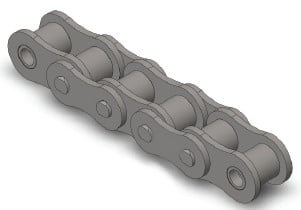The following ways should really be applied to select chain and sprocket sizes, determine the minimal center distance, and determine the length of chain necessary in pitches. We’ll mostly use Imperial units (this kind of as horsepower) on this section nonetheless Kilowatt Capacity tables can be found for every chain dimension within the preceding area. The assortment approach could be the very same regardless of the units utilized.
Step 1: Figure out the Class of your Driven Load
Estimate which of your following most effective characterizes the issue with the drive.
Uniform: Smooth operation. Very little or no shock loading. Soft start up. Moderate: Regular or moderate shock loading.
Hefty: Significant shock loading. Regular begins and stops.
Step 2: Establish the Service Factor
From Table 1 beneath determine the suitable Service Issue (SF) for your drive.
Phase three: Calculate Style and design Power Necessity
Design Horsepower (DHP) = HP x SF (Imperial Units)
or
Design and style Kilowatt Power (DKW) = KW x SF (Metric Units)
The Style Power Requirement is equal for the motor (or engine) output electrical power times the Support Element obtained from Table one.
Phase 4: Create a Tentative Chain Assortment
Create a tentative collection of the needed chain size while in the following method:
1. If working with Kilowatt electrical power – fi rst convert to horsepower for this phase by multiplying the motor Kilowatt rating by one.340 . . . This can be needed because the swift selector chart is proven in horsepower.
2. Locate the Design Horsepower calculated in step three by reading up the single, double, triple or quad chain columns. Draw a horizontal line through this value.
three. Locate the rpm on the tiny sprocket over the horizontal axis from the chart. Draw a vertical line through this worth.
4. The intersection in the two lines really should indicate the tentative chain choice.
Stage five: Pick the number of Teeth to the Small Sprocket
Once a tentative collection of the chain dimension is made we have to identify the minimal amount of teeth necessary over the tiny sprocket essential to transmit the Design and style Horsepower (DHP) or even the Design and style Kilowatt Electrical power (DKW).
Stage six: Identify the quantity of Teeth for the Huge Sprocket
Utilize the following to determine the quantity of teeth for the huge sprocket:
N = (r / R) x n
The amount of teeth over the significant sprocket equals the rpm on the smaller sprocket (r) divided by the preferred rpm of the substantial sprocket (R) occasions the amount of teeth about the modest sprocket. In the event the sprocket is as well massive for that area obtainable then many strand chains of the smaller sized pitch must be checked.
Phase 7: Determine the Minimum Shaft Center Distance
Utilize the following to calculate the minimal shaft center distance (in chain pitches):
C (min) = (2N + n) / six
The over is often a guidebook only.
Stage eight: Verify the Last Assortment
In addition be aware of any probable interference or other space limitations that could exist and modify the variety accordingly. Usually one of the most efficient/cost eff ective drive makes use of single strand chains. This can be for the reason that many strand sprockets are much more highly-priced and as can be ascertained by the multi-strand factors the chains grow to be significantly less effi cient in transmitting electrical power as the number of strands increases. It really is thus typically best to specify single strand chains anytime probable
Step 9: Decide the Length of Chain in Pitches
Make use of the following to calculate the length of your chain (L) in pitches:
L = ((N + n) / two) + (2C) + (K / C)
Values for “K” may very well be uncovered in Table four on webpage 43. Don’t forget that
C could be the shaft center distance given in pitches of chain (not inches or millimeters and so forth). In case the shaft center distance is regarded in the unit of length the worth C is obtained by dividing the chain pitch (from the exact same unit) through the shaft centers.
C = Shaft Centers (inches) / Chain Pitch (inches)
or
C = Shaft Centers (millimeters) / Chain Pitch (millimeters)
Note that every time possible it is finest to utilize an even number of pitches so as to avoid  the use of an off set website link. Off sets never possess precisely the same load carrying capacity since the base chain and must be averted if probable.
the use of an off set website link. Off sets never possess precisely the same load carrying capacity since the base chain and must be averted if probable.
The Drive Chain Variety Method
Tags: